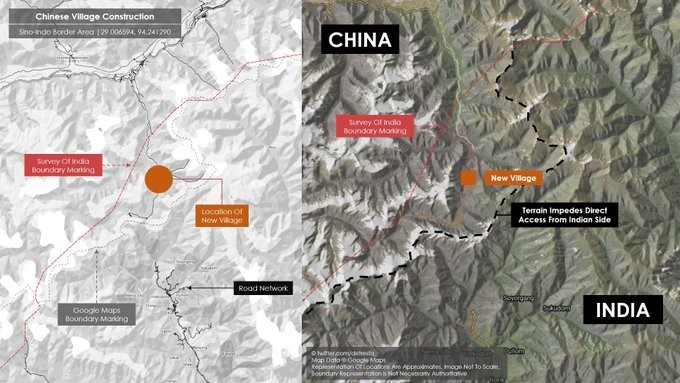China Constructs Another Village Near Arunachal, More In Bhutan, Heliports Along LAC

The village constructed by China appears to be within the survey of India and McMahon line boundary
New Delhi: China has constructed a second village near Arunachal Pradesh, which is outside India’s perception of the Line of Actual Control (LAC) but ‘appears’ to be within the McMahon Line.
A satellite image expert, whose Twitter handle identifies him as @Detresfa_, said the new village “appears to be within the survey of India and McMahon line boundary”.
Meanwhile, a report said, “China has constructed a second enclave or cluster of at least 60 buildings in Arunachal Pradesh”.
It added the new enclave did not exist in 2019 according to the satellite images, but could be seen a year later.
“It lies 93 km east of a China-constructed village in Arunachal Pradesh,” the report said, adding that the second enclave lies approximately 6 kilometres “within India in the region between the Line of Actual Control (LAC) and the International Boundary”.

The village constructed by China appears to be within the survey of India and McMahon line boundary | Twitter | @detresfa_
“We have been given an LAC to defend and we have been doing that. No Chinese intrusion or construction has taken place within India’s perception of the LAC,” a source in the defence establishment said.
Asked about the location of the new Chinese village as revealed in satellite images, the source added, “The coordinates of the village lie north of the LAC and on the Chinese side of the LAC”.
Sources also said there is a gap between the LAC and the McMahon Line, and the Army defends the LAC.
Sources in the defence establishment, however, refused to get into the issue of whether the village fell in an area that is claimed by India, adding that the issue of McMahon line is not for them to deal with.
The McMahon line was drawn at the Shimla Convention of 1913-14 between British India, Tibet and China. However, China treats the Line as illegal.
The first village that China constructed near Arunachal Pradesh last year was on land occupied by the People’s Liberation Army (PLA) by overrunning an Assam Rifles post in 1959.
The area has been under the control of the Chinese since then and is outside the Indian perception of the LAC, but within the McMahon Line.
Eastern Army Commander Lt Gen Manoj Pande had recently red flagged the Chinese construction of villages near the LAC.
China Builds More Villages In Bhutanese Territory
Meanwhile, @Detresfa_ said the disputed land between China and Bhutan shows at least four new Chinese villages being set up since last year, spread through an area of roughly 100 square kilometres.
This construction is said to be on Bhutanese territory that is close to Doklam, the area which saw a stand-off between Indian and Chinese forces in 2017.
Satellite images of China constructing its first village on Bhutanese territory had come out in November last year even as Thimphu denied any such development.
However, sources in the Indian defence establishment had later said that the construction did happen on Bhutanese territory which is now claimed by China.
China Builds More Heliports Near LAC
In a 16 November article on thedrive.com, @detresfa_ wrote that China is developing a network of large heliports across the Tibetan plateau and along its tense border with India that can be of major use in a crisis.
The report gave details of several new heliports and expansion of existing ones, indicating that the Chinese have been carrying out massive military construction activities during the stand-off with India.
Just weeks after the tensions first began along the LAC last year, it was reported that China was building a heliport in Ladakh and near Doklam.
Sources had then said that expansions fit into a South China Sea-like strategy, which suggests Beijing plans to aggressively pursue its western territorial claims.



No comments:
Post a Comment